
Cathedral Close–a short history and photo tour
Page updated 28th November 2016
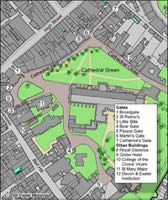 The Cathedral Close
has been the heart of Exeter since the Romans built their bath
house, and basilica, in the First and Second Centuries. Christianity was established by 680 when a young man from Crediton who was educated at the Minster, would became St Boniface,
of Germany. Leofric,
Bishop of Devon and Cornwall, was based in Crediton, when he obtained
permission to move to the walled city of Exeter, to escape marauding Danish raiders. He arrived in 1050 and worked to
improve an impoverished church in the city, survived the Norman
invasion, and helped a smooth transition to Norman rule.
Work was
started on a new Cathedral in 1114 by Bishop Warelwast, and by 1200, the two great towers were complete. A period of rebuilding commenced in 1270, turning the Cathedral Yard into a
massive building site, and a magnet for every vagrant around.
The Cathedral Close
has been the heart of Exeter since the Romans built their bath
house, and basilica, in the First and Second Centuries. Christianity was established by 680 when a young man from Crediton who was educated at the Minster, would became St Boniface,
of Germany. Leofric,
Bishop of Devon and Cornwall, was based in Crediton, when he obtained
permission to move to the walled city of Exeter, to escape marauding Danish raiders. He arrived in 1050 and worked to
improve an impoverished church in the city, survived the Norman
invasion, and helped a smooth transition to Norman rule.
Work was
started on a new Cathedral in 1114 by Bishop Warelwast, and by 1200, the two great towers were complete. A period of rebuilding commenced in 1270, turning the Cathedral Yard into a
massive building site, and a magnet for every vagrant around.
The Yard is Walled
After the murder of Walter Lechlade in 1283, Bishop Quinell obtained permission, from Edward I, to build a wall around Cathedral Yard with seven gates, to be locked at night. It was this single act that delineated the boundary of church authority over the secular within Exeter.
By 1637, the churchyard was overcrowded with burials, as the ground level had risen to just below the cathedral windows. Bartholomews Yard was opened in November of the same year, while the Cathedral Yard closed for new interments. The first book, entitled Good Thoughts in Bad Times, to be printed in the city was printed by Thomas Hart in 1645 in St Peter's Yard; this was on a travelling press, which no doubt saw service during the Civil War, printing propaganda pamphlets. One of the earliest newspapers in the country, the Exeter Mercury, was first printed by Philip Bishop, also in St Peter's Yard, in 1714. In November 1703, a great storm swept the south-west, uprooting many of the large elms in Cathedral Yard. The limes that replaced them did not thrive, so more, young elms were planted, some of which survived into the twentieth century.
The Assembly Rooms, built in 1769 by William Mackworth Praed became England's first hotel in 1770, known as the Royal Clarence Hotel. The great improvements of the early nineteenth century did not bypass the buildings around Cathedral Yard–in 1825 the old Broadgate was demolished and the building now housing Pizza Express was constructed. The Close was the venue for the annual Saturnalia or November 5th bonfire, when city folk would celebrate the thwarting of Guy Fawkes, and burn effigies of the Pope and others, whom they thought religiously subversive. Riots would ensue and peole died from burns, before the practice was banned towards the end of the nineteenth century, to preserve public safety, and safeguard the the Cathedral from heat damage.
The Globe Hotel was lost to fire and the house where John Simcoe, the first Governor of Canada died, were totally destroyed in the 1942 blitz–the latter has been faithfully rebuilt. In 1971, St Mary Major Church, was demolished, and the foundations excavated, unveiling Saxon burials , and beneath these, a Roman bath house. After an investigation by archaeologists, the site was covered with sand and grassed over.
A walk around the Close starting at site of St Mary Major Church which is marked with a metal cross in front of the Great West Front.

 St Mary Major Church
St Mary Major Church
The original, pre-Cathedral monastery was on the site of St Mary Major Church. The monastery became a church in the early 13th Century. By the 1860s the building was in disrepair, so it was demolished, and rebuilt, using some of the old stonework. By the 1960s the church was redundant and the decision was made to demolish it in 1971. The site was excavated by archeologists who found the remains of a Roman bath house under the foundations.
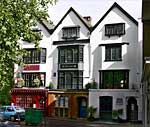 The Three Gables
The Three Gables
The group of three
terraced houses in the north-west corner of Cathedral Yard is known as
the Three Gables. The site was originally occupied by a workhouse (a building to house workers and materials) The three buildings were constructed in 1558, to house Cathedral craftsmen. The business of Frederick Drake, the stained glass craftsman, was based in No 4 from 1865 until the Second War, while the publishers of 'The Country Diary of an Edwardian Lady' were also based in one of the buildings.
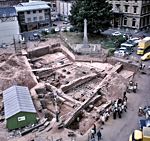 The Roman Bath House
The Roman Bath House
When St Mary Major was demolished in 1971, archeologists found the remains of a Roman Bath House. Major excavations were carried out the next summer. When complete, the remains were covered with sand in the hope they could be exposed some day in the future. The Cathedral applied for funding to open up the bath house in 2014, but were turned down. They intend to apply again, and if successful, build an interpretation centre over the remains.
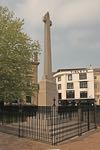 Devon War Memorial
Devon War Memorial
The Devon War Memorial was designed by the architect Sir Edwin Lutyens, and made out of a single piece of Haytor granite. The Haytor quarry, which supplied the granite for London Bridge (the one in Arizona!), was reopened in 1919 especially to extract the stone for the memorial. It was
unveiled in 1921 by the Prince of Wales.
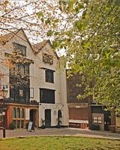 Little Stile
Little Stile
No longer in existence, Little Stile was a postern gate of approximately 5ft width. It was a route that went from the pathway in front of the Three Gables, to South Street, with the northern side bounded by the Globe Hotel. When it was removed, a sign was put up with the inscription "Gate removed 1820. No Passage at night. But by leave of the Dean & Chapter", and a ring fixed to the wall on each side. The destruction of the Globe Hotel and the rebuilding of South Street after the war permanently blocked Little Stile.
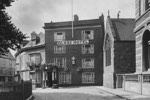 Globe Hotel
Globe Hotel
The Globe Tavern was noted as a centre for cockfighting in the 18th century. Local citizens met there for the annual 5th November celebration of the attempted blowing up of Parliament by Guido Fawkes. Its rooms were also used by Britain's first bee keeping association, for their meetings between 1797 and 1807. The Globe was also important to Freemasonry in Devon when it became the meeting place in 1774 of the Provincial Grand Lodge of Devon Freemasons, founded by Sir Charles Bampfylde who was the Master of the Lodge. Little Stile was the gap on the left of the building.
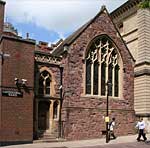 St Petrocks Church
St Petrocks Church
St Petrock's Church is one of
the traditional seven gates into the Close. The oldest part of the
building fronts the High Street. It maybe the oldest church in Exeter, with some thinking it was founded by St Petrock, the 6th century Cornish saint. Some sources are more conservative and date its founding to the 11th-century. It was one of twenty-nine churches which William the Conqueror directed the City Provost to pay one silver penny out of the public taxes.
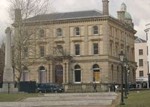
 City Bank
City Bank
Established in 1786 by Samuel Milford and Richard Hall Clark, the City Bank's first premises were on the corner of Bear Street, near the Deanery. Milford was a successful serge and woollen merchant. The partners contributed £15,000 each to the business, who then engaged "a steadyclerk of... undoubted character". In 1793 the bank moved to a newly built banking hall close to Broadgate. The bank merged with the Devon and Cornwall Bank and rebuilt its premises in 1876, into what you see today.
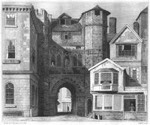
 Broadgate
Broadgate
A little further east can be found Broadgate, the, ancient grand, entrance to Cathedral Yard. It was the greatest of the seven gates, and was the ceremonial entrance to the Close. The gate was demolished in 1825, and is now a short street linking the High Street with Cathedral Yard, with the position of the gate marked with a post.
 Pizza Express & National Westminster Bank
Pizza Express & National Westminster Bank
On the corner of Broadgate Pizza Express, remembered fondly by many as Tinleys Tea Shop. Charlotte Treadwin, Queen Victoria's favourite lace maker, had her first lace showroom on the site of Pizza Express. The bank building was originally the National Provincial Bank, and dates from before 1860.
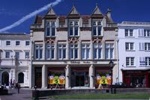
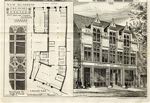 Edinburgh Wool Shop
Edinburgh Wool Shop
On the right
is the original architects drawing for Wippells,
dating from the 1880's. Joseph Wippell Jnr., established his drapery business in 1834. The company became the leading supplier of ecclesiastical drapery in the country, and now trade from premises in St Thomas. The building on Cathedral Yard walked through to their showroom on the High Street. It now houses Edinburgh Wool.
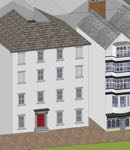
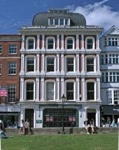 18 Cathedral Yard (The Mansion House)
18 Cathedral Yard (The Mansion House)
This attractive building, was constructed by a dentist named Brand in 1871, in what was described, at the time, as a 'French chateau style'. An impression of the building before 1871 is shown, left. The lane on the right was Lamb Alley, which once gave access to workshops and tenements between the buildings on Cathedral Yard and the High Street. The October 2016 fire started in this building–thankfully, the facade has survived and hopefully it will be restored.
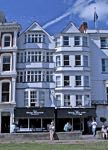 Well House
Well House
The fabric of the two buildings of the Well House are timber framed, and date from the 16th and 17th Centuries, with Saxon stone work in the cellars, and a well that is probably Norman. Two shops for hundreds of years, including the retail outlet for Veitch's, the nursery, it became the Well House pub in 1984. Badly damaged by fire in October 2016.
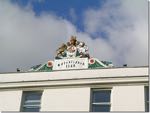
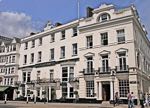 Royal Clarence Hotel and Exeter Bank.
Royal Clarence Hotel and Exeter Bank.
The first establishment to be called a 'hotel' in the country, the Royal Clarence has hosted film stars, authors and Royals over the years. It was gutted by fire in October 2016–the owners have vowed to rebuild the front in the same style. The corner building opened as the Exeter Bank in 1769, and was also Dellers cafe from 1905 to 1919, before it became part of the hotel.
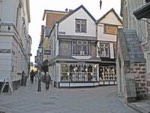
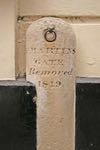 St Martin's Gate
St Martin's Gate
One of seven gates around the Close, constructed after the murder of Walter Lechlade in 1283. The gate was removed in August 1819, during the driest and hottest weather of the previous 20 years. Traces of the gate can be seen in the shop on the corner, while two posts marks its position.
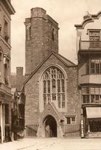 St Martin's Church
St Martin's Church
This is one of the oldest churches in Exeter St Martin's was consecrated by Bishop Leofric on 6th July 1065. The church was dedicated to St Martin of Tours, the patron saint of beggars. Some original Anglo-Saxon stonework in the walls remains, including the use of Beer stone. The roughcast tower is built of red Heavitree sandstone. The roof is typical Devon style 'wagon' roof, although the mullions are made of wood, rather than stone. The porch was added in the 19th century.
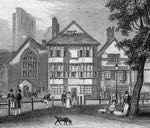
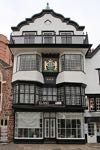 Mol's Coffee House
Mol's Coffee House
This iconic building housed 'Annuellars', or priests. Annuellars attended to the last wishes of benefactors to the Cathedral. It became a coffee house run by a succession of women from 1726, and then an art gallery from 1833. The top story was remodelled in 1879, and the building was used to promote tourism in the city by Worth's Galleries.
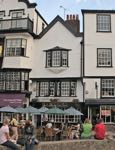 2 & 3 Cathedral Close (Tea on the Green)
2 & 3 Cathedral Close (Tea on the Green)
Built by the Cathedral Authorities to house 'Annuellars'. The Reformation of the 1530s saw these practices abandoned. John Trickey, a boot maker, occupied it from 1866 to 1898. For the last 60 years it has been a restaurant and tea rooms. The next two houses were also built for the 'Annuellars'.
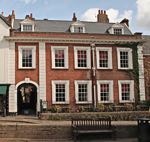 5 Cathedral Close–Ask
5 Cathedral Close–Ask
The last in a row to have started life as housing for 'Annuellars'. The present structure dates from 1729 when the site was purchased by Francis Drewe, who built himself a town house fit for a gentleman. The Dean and Chapter leased the building to Charlotte Treadwin, in 1867, for her Honiton lace business, which included workshops and a showroom. Treadwin was a favourite of Queen Victoria, who purchased several pieces of her lace, and granted her the Royal Warrant
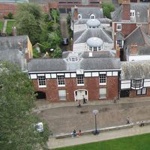 7 Cathedral Close (Devon and Exeter Institution)
7 Cathedral Close (Devon and Exeter Institution)
At
7 Cathedral Close can be found the, members
only, Devon
& Exeter Institution, dedicated to promoting the arts and
science, and preserving documents and
books about Exeter and the south-west. It was formerly the town house
of the Courtenay family. Photo by Nadezhda Keenan.
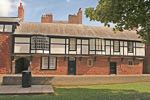 8 & 9 Cathedral Close
8 & 9 Cathedral Close
This was once the home of the Cathedral canons, and dates from about 1500. Inside the Law Library has a fine hammer beam roof, the construction of which is similar in style to that of Westminster Hall. The three storey Notaries House at the rear, is in Queen Anne style. The front now houses Chandni Chowk, which sells Indian soft furnishings.
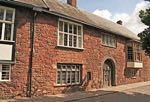 10 Cathedral Close
10 Cathedral Close
Now occupied by the Dean of Exeter, the oldest parts of the building date to the 14th Century. It has been the residence of the chancellor of the Cathedral, the Treasurer and the Chief Verger. Inside is a carved ceiling, bearing the arms of the Courtenay family, the historian Hake, Bishops Fox, Lacey and Oldham, and Lady Margaret Beaufort.
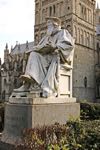 Hooker Statue
Hooker Statue
Richard Hooker was born in Heavitree in 1554 and educated at Exeter Grammar School. The statue, unveiled in 1907, is of, is carved out of white 'pentilicon' marble, by Alfred Drury RA (1856-1944), at a cost of a thousand guineas.
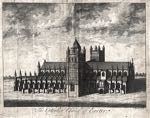 The Cathedral
The Cathedral
This page is too short to cover the history and architecture of the Cathedral. But it is because of the Cathedral, that the Close exists. The West Front is a glory of Gothic carving, while the towers have the earlier, solid construction from the Normans. Enjoy the Green, Close and Yard, especially on a sunny day, and marvel at the two thousand years of history in such a compact place. The illustration, from Izacke's History of Exeter, shows the North Tower with a spire.